Statistics Assignment: Data Analysis using SPSS Software
VerifiedAdded on 2020/02/05
|17
|1865
|63
Homework Assignment
AI Summary
This statistics assignment utilizes SPSS software to analyze a dataset, covering descriptive statistics, graphical representations, and hypothesis testing. The assignment explores job classifications and age distributions, employing frequency tables and graphical interpretations. It delves into hypothesis tests comparing the mean weight of men and women with knee surgery. Further analysis includes tests on the proportion of people with knee replacements and comparisons of return-to-work times and mean weight differences between TKR and UKA patients. The solution also addresses the sample size required for 90% power and concludes with a short report summarizing the findings. The analysis involves t-tests, chi-square tests, and interpretations of confidence intervals and p-values. The assignment demonstrates the application of statistical tools and techniques in data analysis, providing insights into the analysis of medical and demographic data.
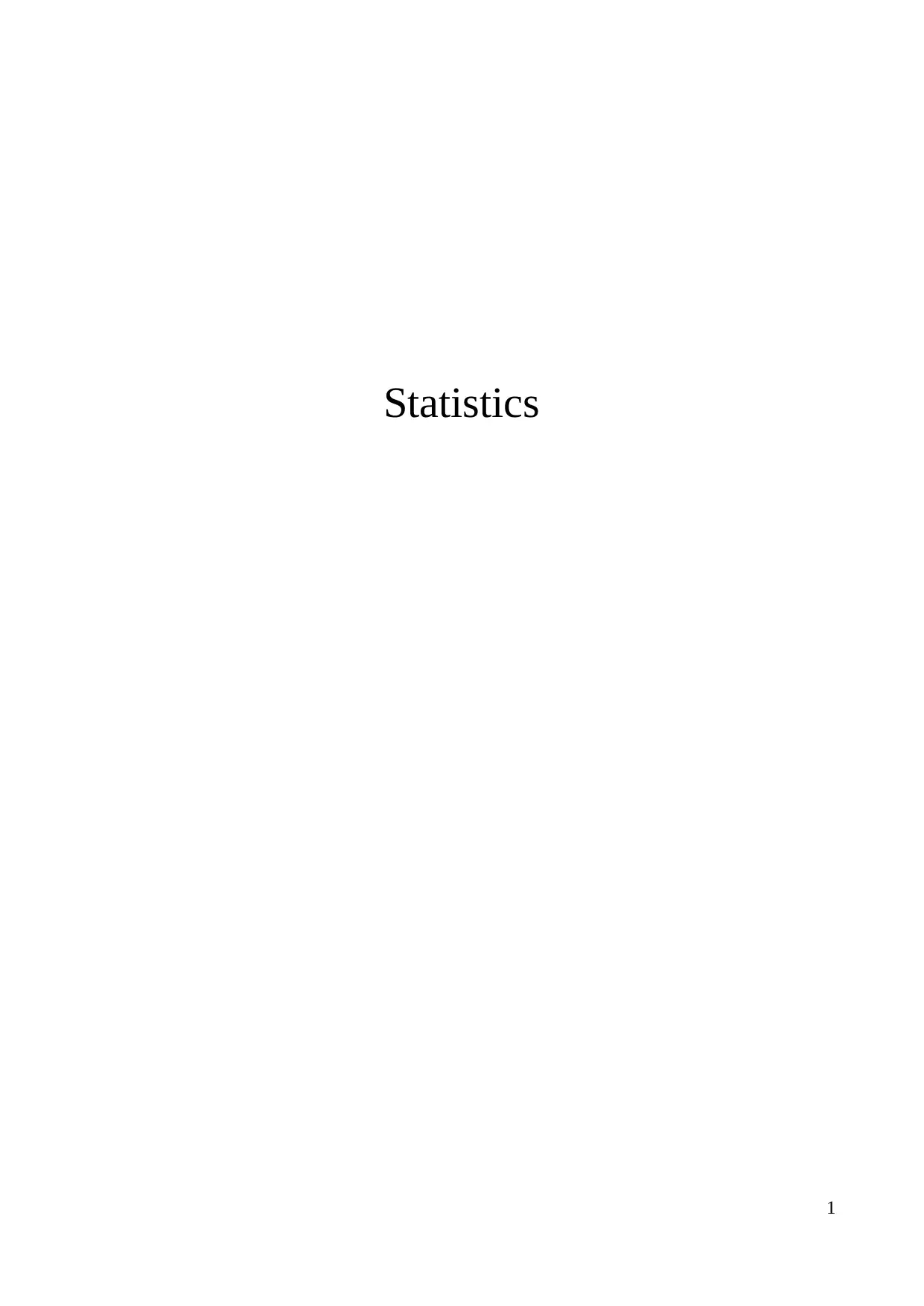
Statistics
1
1
Paraphrase This Document
Need a fresh take? Get an instant paraphrase of this document with our AI Paraphraser
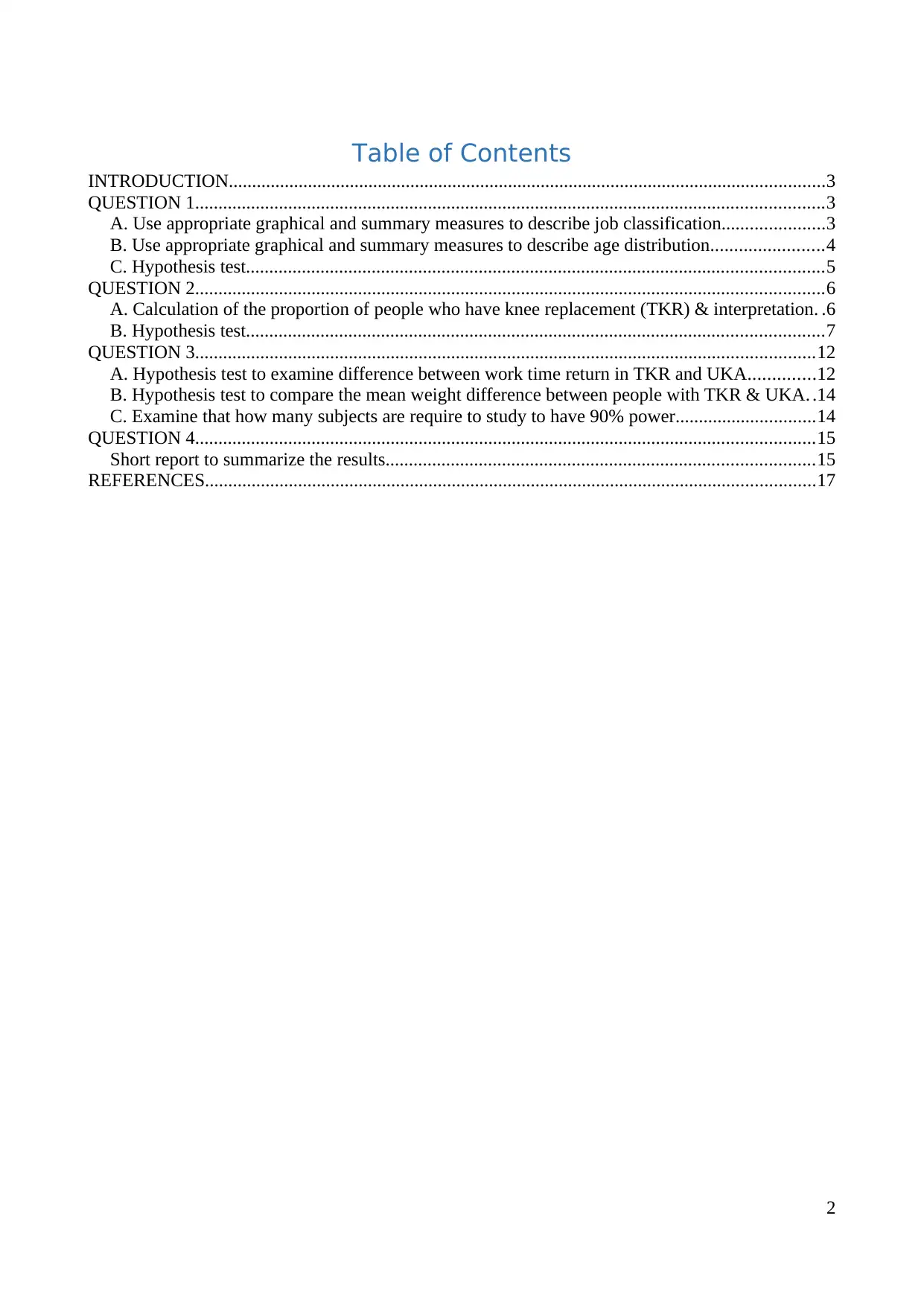
Table of Contents
INTRODUCTION................................................................................................................................3
QUESTION 1.......................................................................................................................................3
A. Use appropriate graphical and summary measures to describe job classification......................3
B. Use appropriate graphical and summary measures to describe age distribution........................4
C. Hypothesis test............................................................................................................................5
QUESTION 2.......................................................................................................................................6
A. Calculation of the proportion of people who have knee replacement (TKR) & interpretation. .6
B. Hypothesis test............................................................................................................................7
QUESTION 3.....................................................................................................................................12
A. Hypothesis test to examine difference between work time return in TKR and UKA..............12
B. Hypothesis test to compare the mean weight difference between people with TKR & UKA. .14
C. Examine that how many subjects are require to study to have 90% power..............................14
QUESTION 4.....................................................................................................................................15
Short report to summarize the results............................................................................................15
REFERENCES...................................................................................................................................17
2
INTRODUCTION................................................................................................................................3
QUESTION 1.......................................................................................................................................3
A. Use appropriate graphical and summary measures to describe job classification......................3
B. Use appropriate graphical and summary measures to describe age distribution........................4
C. Hypothesis test............................................................................................................................5
QUESTION 2.......................................................................................................................................6
A. Calculation of the proportion of people who have knee replacement (TKR) & interpretation. .6
B. Hypothesis test............................................................................................................................7
QUESTION 3.....................................................................................................................................12
A. Hypothesis test to examine difference between work time return in TKR and UKA..............12
B. Hypothesis test to compare the mean weight difference between people with TKR & UKA. .14
C. Examine that how many subjects are require to study to have 90% power..............................14
QUESTION 4.....................................................................................................................................15
Short report to summarize the results............................................................................................15
REFERENCES...................................................................................................................................17
2
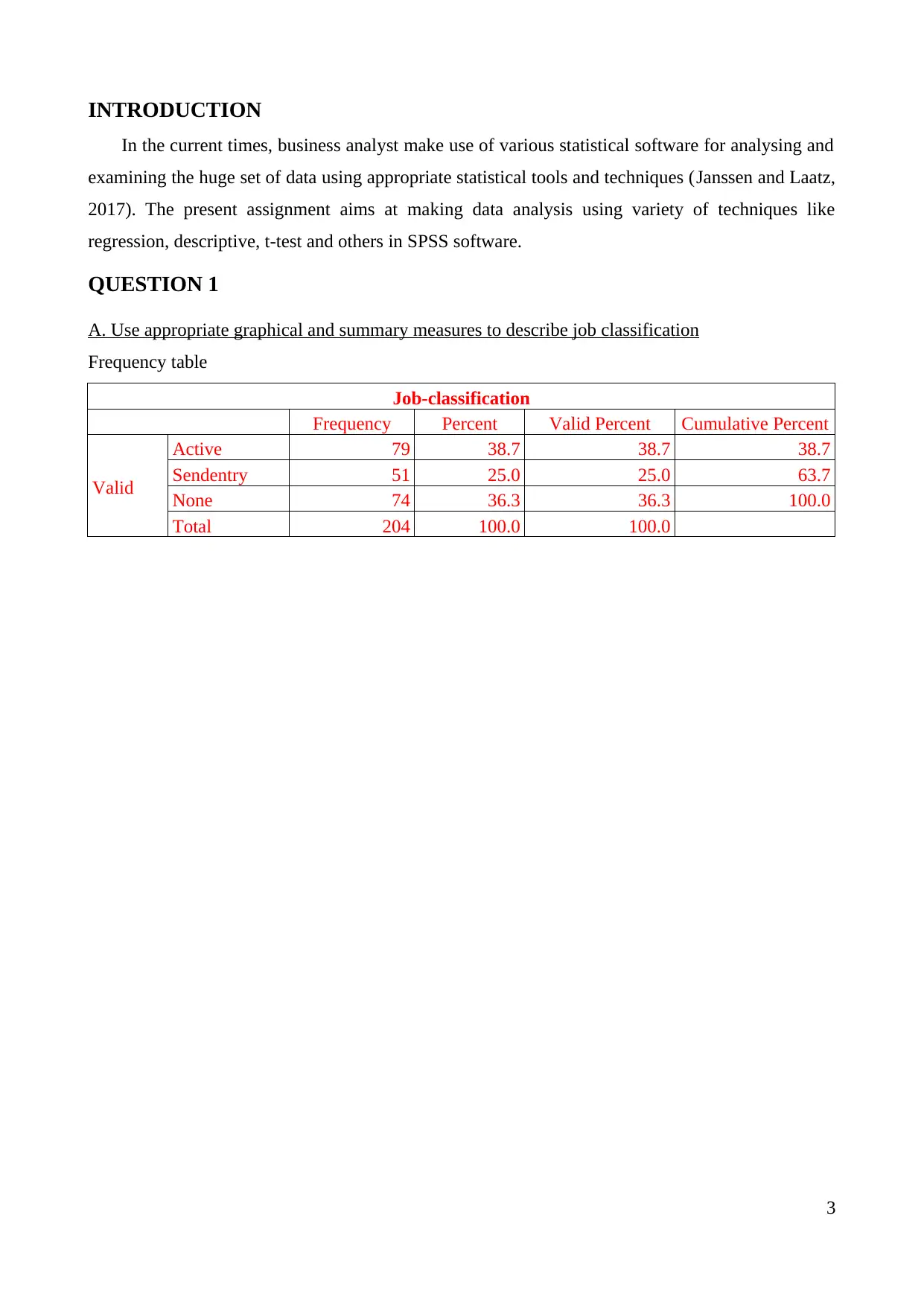
INTRODUCTION
In the current times, business analyst make use of various statistical software for analysing and
examining the huge set of data using appropriate statistical tools and techniques (Janssen and Laatz,
2017). The present assignment aims at making data analysis using variety of techniques like
regression, descriptive, t-test and others in SPSS software.
QUESTION 1
A. Use appropriate graphical and summary measures to describe job classification
Frequency table
Job-classification
Frequency Percent Valid Percent Cumulative Percent
Valid
Active 79 38.7 38.7 38.7
Sendentry 51 25.0 25.0 63.7
None 74 36.3 36.3 100.0
Total 204 100.0 100.0
3
In the current times, business analyst make use of various statistical software for analysing and
examining the huge set of data using appropriate statistical tools and techniques (Janssen and Laatz,
2017). The present assignment aims at making data analysis using variety of techniques like
regression, descriptive, t-test and others in SPSS software.
QUESTION 1
A. Use appropriate graphical and summary measures to describe job classification
Frequency table
Job-classification
Frequency Percent Valid Percent Cumulative Percent
Valid
Active 79 38.7 38.7 38.7
Sendentry 51 25.0 25.0 63.7
None 74 36.3 36.3 100.0
Total 204 100.0 100.0
3
⊘ This is a preview!⊘
Do you want full access?
Subscribe today to unlock all pages.

Trusted by 1+ million students worldwide
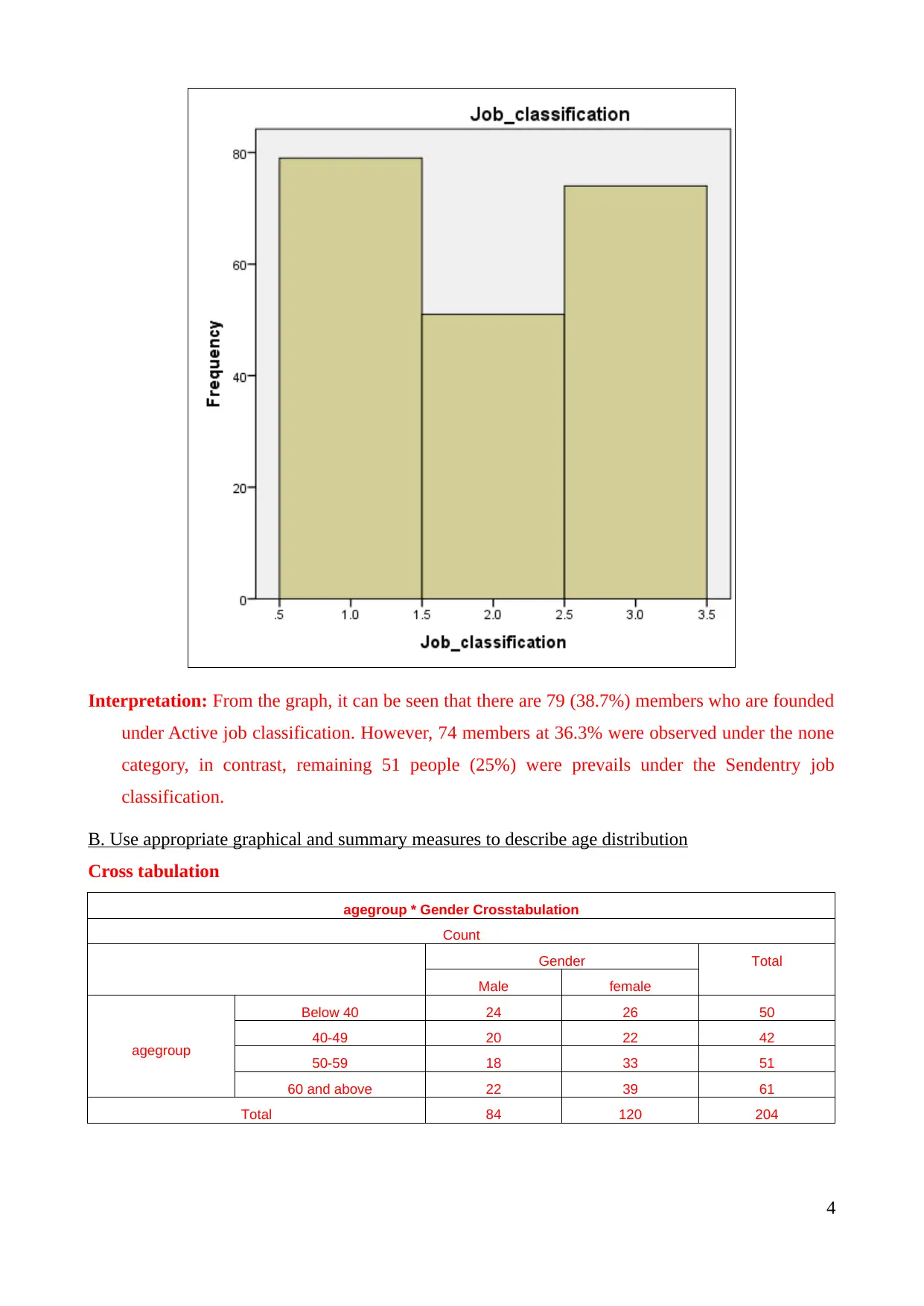
Interpretation: From the graph, it can be seen that there are 79 (38.7%) members who are founded
under Active job classification. However, 74 members at 36.3% were observed under the none
category, in contrast, remaining 51 people (25%) were prevails under the Sendentry job
classification.
B. Use appropriate graphical and summary measures to describe age distribution
Cross tabulation
agegroup * Gender Crosstabulation
Count
Gender Total
Male female
agegroup
Below 40 24 26 50
40-49 20 22 42
50-59 18 33 51
60 and above 22 39 61
Total 84 120 204
4
under Active job classification. However, 74 members at 36.3% were observed under the none
category, in contrast, remaining 51 people (25%) were prevails under the Sendentry job
classification.
B. Use appropriate graphical and summary measures to describe age distribution
Cross tabulation
agegroup * Gender Crosstabulation
Count
Gender Total
Male female
agegroup
Below 40 24 26 50
40-49 20 22 42
50-59 18 33 51
60 and above 22 39 61
Total 84 120 204
4
Paraphrase This Document
Need a fresh take? Get an instant paraphrase of this document with our AI Paraphraser
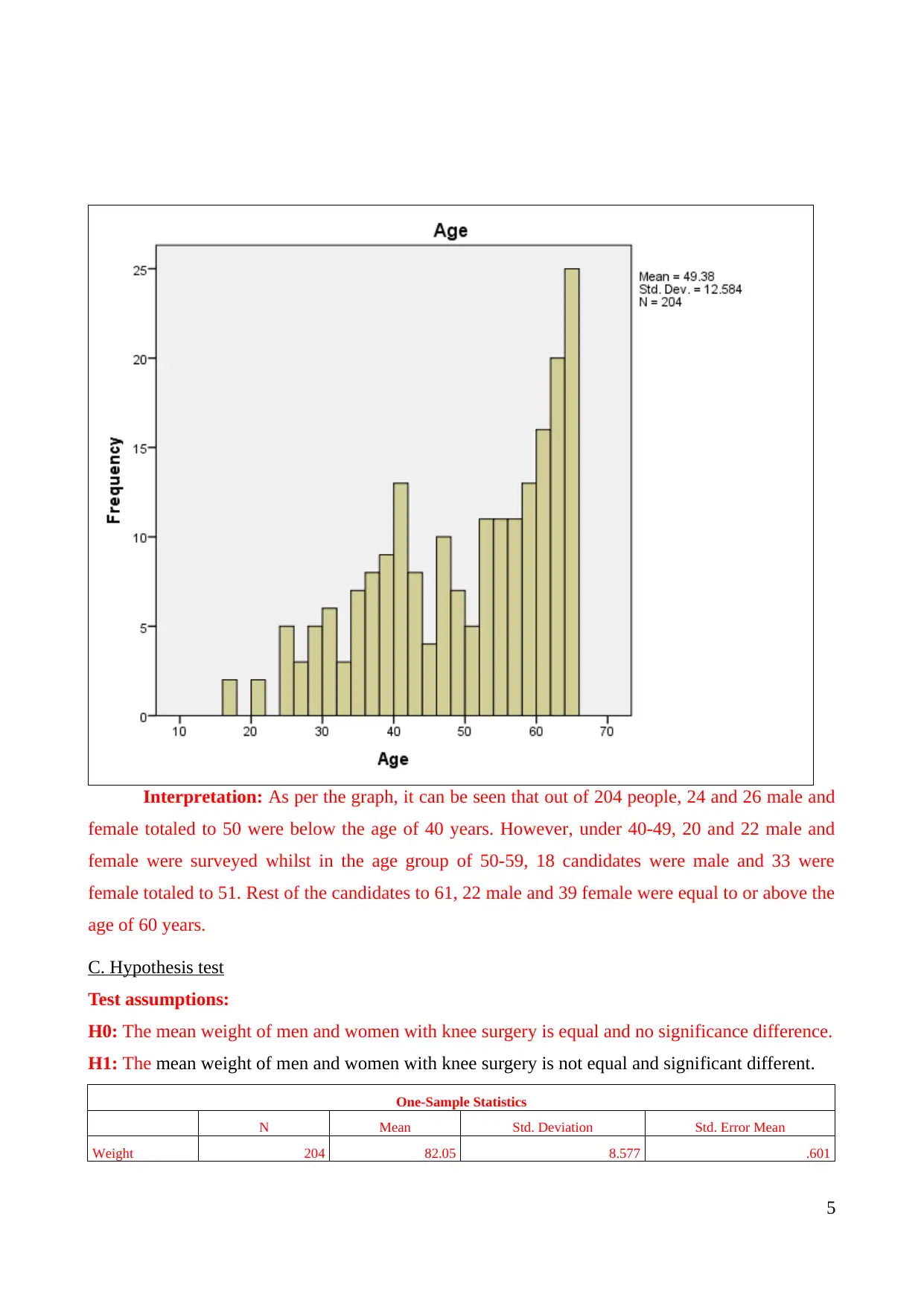
Interpretation: As per the graph, it can be seen that out of 204 people, 24 and 26 male and
female totaled to 50 were below the age of 40 years. However, under 40-49, 20 and 22 male and
female were surveyed whilst in the age group of 50-59, 18 candidates were male and 33 were
female totaled to 51. Rest of the candidates to 61, 22 male and 39 female were equal to or above the
age of 60 years.
C. Hypothesis test
Test assumptions:
H0: The mean weight of men and women with knee surgery is equal and no significance difference.
H1: The mean weight of men and women with knee surgery is not equal and significant different.
One-Sample Statistics
N Mean Std. Deviation Std. Error Mean
Weight 204 82.05 8.577 .601
5
female totaled to 50 were below the age of 40 years. However, under 40-49, 20 and 22 male and
female were surveyed whilst in the age group of 50-59, 18 candidates were male and 33 were
female totaled to 51. Rest of the candidates to 61, 22 male and 39 female were equal to or above the
age of 60 years.
C. Hypothesis test
Test assumptions:
H0: The mean weight of men and women with knee surgery is equal and no significance difference.
H1: The mean weight of men and women with knee surgery is not equal and significant different.
One-Sample Statistics
N Mean Std. Deviation Std. Error Mean
Weight 204 82.05 8.577 .601
5
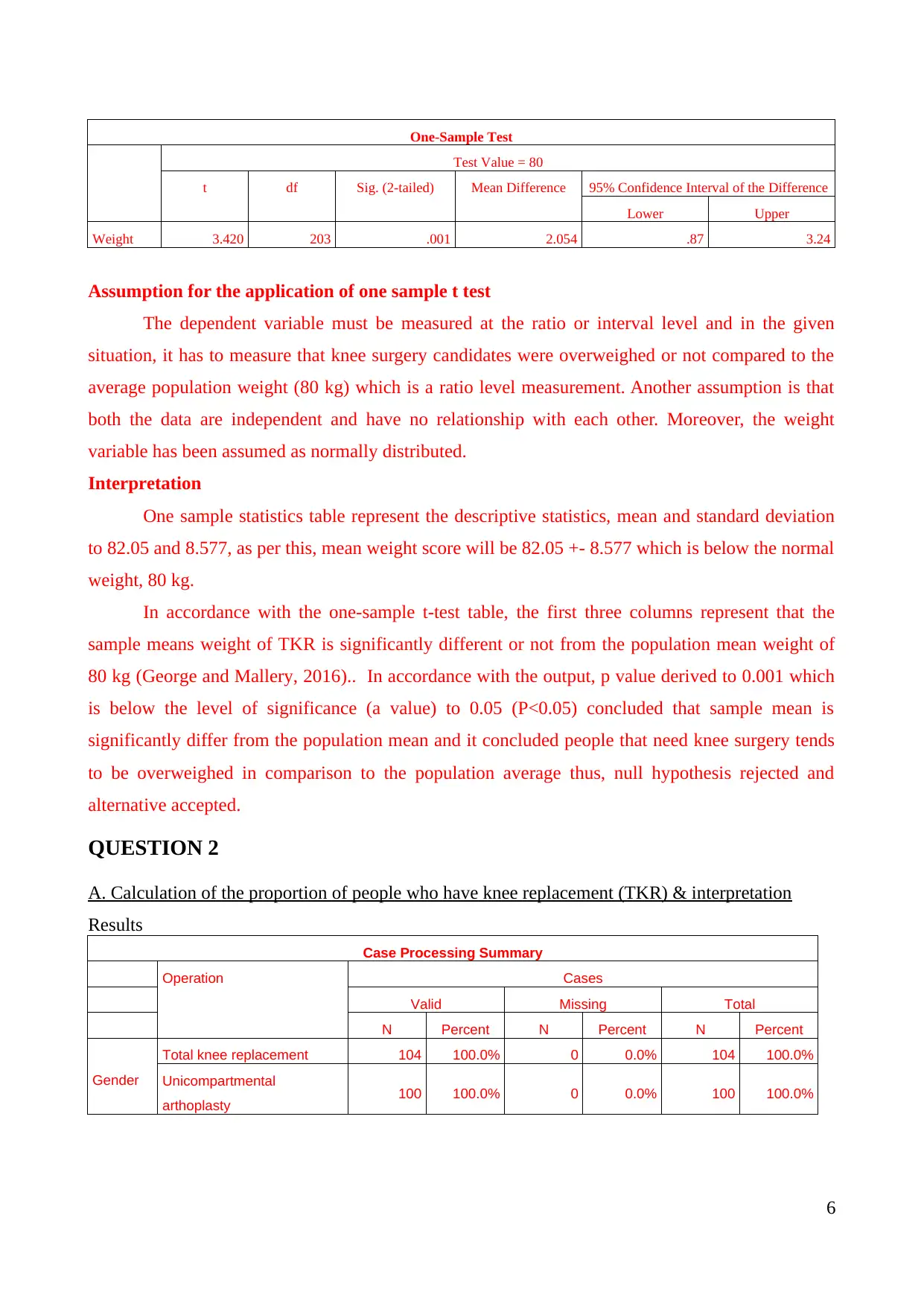
One-Sample Test
Test Value = 80
t df Sig. (2-tailed) Mean Difference 95% Confidence Interval of the Difference
Lower Upper
Weight 3.420 203 .001 2.054 .87 3.24
Assumption for the application of one sample t test
The dependent variable must be measured at the ratio or interval level and in the given
situation, it has to measure that knee surgery candidates were overweighed or not compared to the
average population weight (80 kg) which is a ratio level measurement. Another assumption is that
both the data are independent and have no relationship with each other. Moreover, the weight
variable has been assumed as normally distributed.
Interpretation
One sample statistics table represent the descriptive statistics, mean and standard deviation
to 82.05 and 8.577, as per this, mean weight score will be 82.05 +- 8.577 which is below the normal
weight, 80 kg.
In accordance with the one-sample t-test table, the first three columns represent that the
sample means weight of TKR is significantly different or not from the population mean weight of
80 kg (George and Mallery, 2016).. In accordance with the output, p value derived to 0.001 which
is below the level of significance (a value) to 0.05 (P<0.05) concluded that sample mean is
significantly differ from the population mean and it concluded people that need knee surgery tends
to be overweighed in comparison to the population average thus, null hypothesis rejected and
alternative accepted.
QUESTION 2
A. Calculation of the proportion of people who have knee replacement (TKR) & interpretation
Results
Case Processing Summary
Operation Cases
Valid Missing Total
N Percent N Percent N Percent
Gender
Total knee replacement 104 100.0% 0 0.0% 104 100.0%
Unicompartmental
arthoplasty 100 100.0% 0 0.0% 100 100.0%
6
Test Value = 80
t df Sig. (2-tailed) Mean Difference 95% Confidence Interval of the Difference
Lower Upper
Weight 3.420 203 .001 2.054 .87 3.24
Assumption for the application of one sample t test
The dependent variable must be measured at the ratio or interval level and in the given
situation, it has to measure that knee surgery candidates were overweighed or not compared to the
average population weight (80 kg) which is a ratio level measurement. Another assumption is that
both the data are independent and have no relationship with each other. Moreover, the weight
variable has been assumed as normally distributed.
Interpretation
One sample statistics table represent the descriptive statistics, mean and standard deviation
to 82.05 and 8.577, as per this, mean weight score will be 82.05 +- 8.577 which is below the normal
weight, 80 kg.
In accordance with the one-sample t-test table, the first three columns represent that the
sample means weight of TKR is significantly different or not from the population mean weight of
80 kg (George and Mallery, 2016).. In accordance with the output, p value derived to 0.001 which
is below the level of significance (a value) to 0.05 (P<0.05) concluded that sample mean is
significantly differ from the population mean and it concluded people that need knee surgery tends
to be overweighed in comparison to the population average thus, null hypothesis rejected and
alternative accepted.
QUESTION 2
A. Calculation of the proportion of people who have knee replacement (TKR) & interpretation
Results
Case Processing Summary
Operation Cases
Valid Missing Total
N Percent N Percent N Percent
Gender
Total knee replacement 104 100.0% 0 0.0% 104 100.0%
Unicompartmental
arthoplasty 100 100.0% 0 0.0% 100 100.0%
6
⊘ This is a preview!⊘
Do you want full access?
Subscribe today to unlock all pages.

Trusted by 1+ million students worldwide
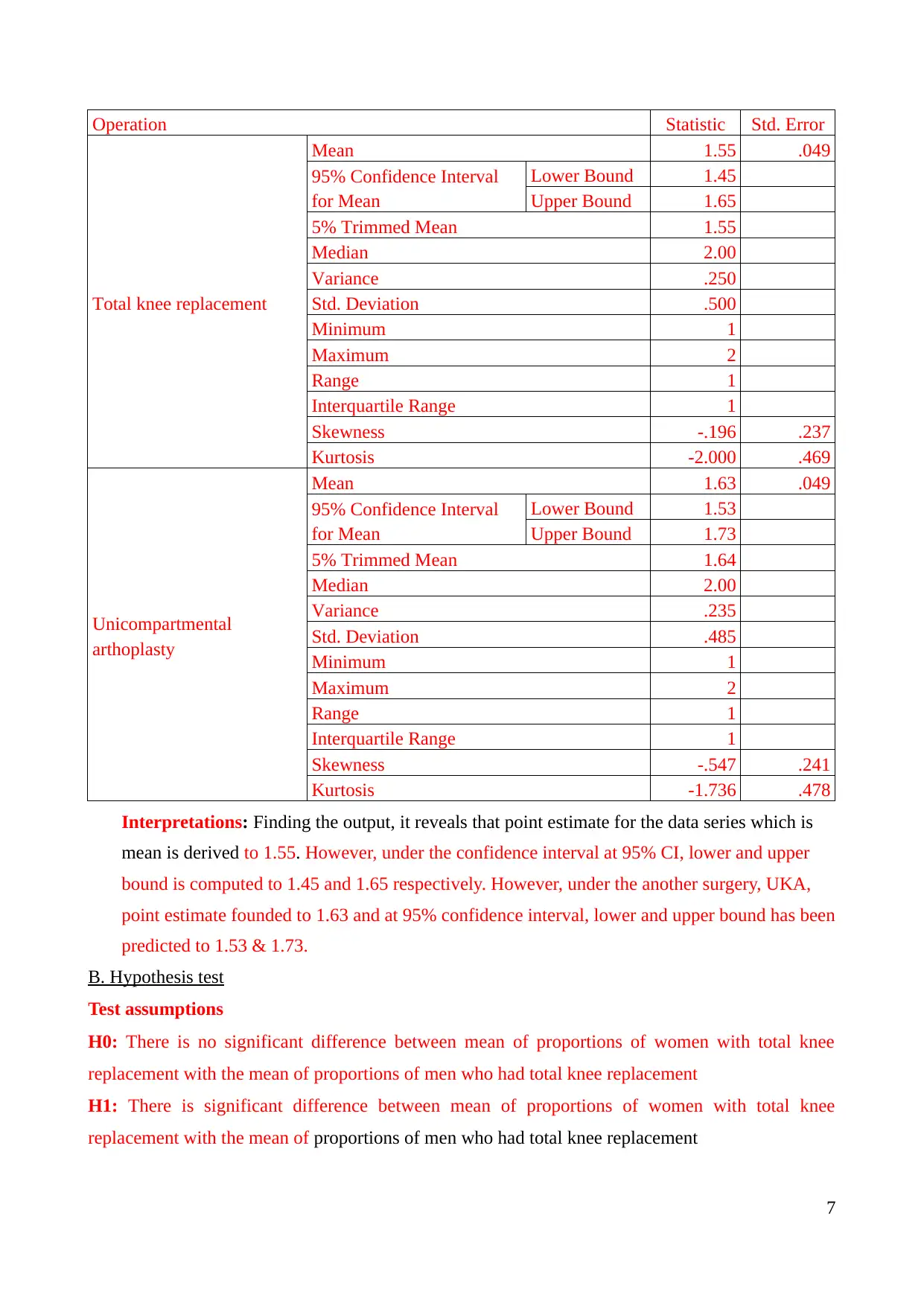
Operation Statistic Std. Error
Total knee replacement
Mean 1.55 .049
95% Confidence Interval
for Mean
Lower Bound 1.45
Upper Bound 1.65
5% Trimmed Mean 1.55
Median 2.00
Variance .250
Std. Deviation .500
Minimum 1
Maximum 2
Range 1
Interquartile Range 1
Skewness -.196 .237
Kurtosis -2.000 .469
Unicompartmental
arthoplasty
Mean 1.63 .049
95% Confidence Interval
for Mean
Lower Bound 1.53
Upper Bound 1.73
5% Trimmed Mean 1.64
Median 2.00
Variance .235
Std. Deviation .485
Minimum 1
Maximum 2
Range 1
Interquartile Range 1
Skewness -.547 .241
Kurtosis -1.736 .478
Interpretations: Finding the output, it reveals that point estimate for the data series which is
mean is derived to 1.55. However, under the confidence interval at 95% CI, lower and upper
bound is computed to 1.45 and 1.65 respectively. However, under the another surgery, UKA,
point estimate founded to 1.63 and at 95% confidence interval, lower and upper bound has been
predicted to 1.53 & 1.73.
B. Hypothesis test
Test assumptions
H0: There is no significant difference between mean of proportions of women with total knee
replacement with the mean of proportions of men who had total knee replacement
H1: There is significant difference between mean of proportions of women with total knee
replacement with the mean of proportions of men who had total knee replacement
7
Total knee replacement
Mean 1.55 .049
95% Confidence Interval
for Mean
Lower Bound 1.45
Upper Bound 1.65
5% Trimmed Mean 1.55
Median 2.00
Variance .250
Std. Deviation .500
Minimum 1
Maximum 2
Range 1
Interquartile Range 1
Skewness -.196 .237
Kurtosis -2.000 .469
Unicompartmental
arthoplasty
Mean 1.63 .049
95% Confidence Interval
for Mean
Lower Bound 1.53
Upper Bound 1.73
5% Trimmed Mean 1.64
Median 2.00
Variance .235
Std. Deviation .485
Minimum 1
Maximum 2
Range 1
Interquartile Range 1
Skewness -.547 .241
Kurtosis -1.736 .478
Interpretations: Finding the output, it reveals that point estimate for the data series which is
mean is derived to 1.55. However, under the confidence interval at 95% CI, lower and upper
bound is computed to 1.45 and 1.65 respectively. However, under the another surgery, UKA,
point estimate founded to 1.63 and at 95% confidence interval, lower and upper bound has been
predicted to 1.53 & 1.73.
B. Hypothesis test
Test assumptions
H0: There is no significant difference between mean of proportions of women with total knee
replacement with the mean of proportions of men who had total knee replacement
H1: There is significant difference between mean of proportions of women with total knee
replacement with the mean of proportions of men who had total knee replacement
7
Paraphrase This Document
Need a fresh take? Get an instant paraphrase of this document with our AI Paraphraser
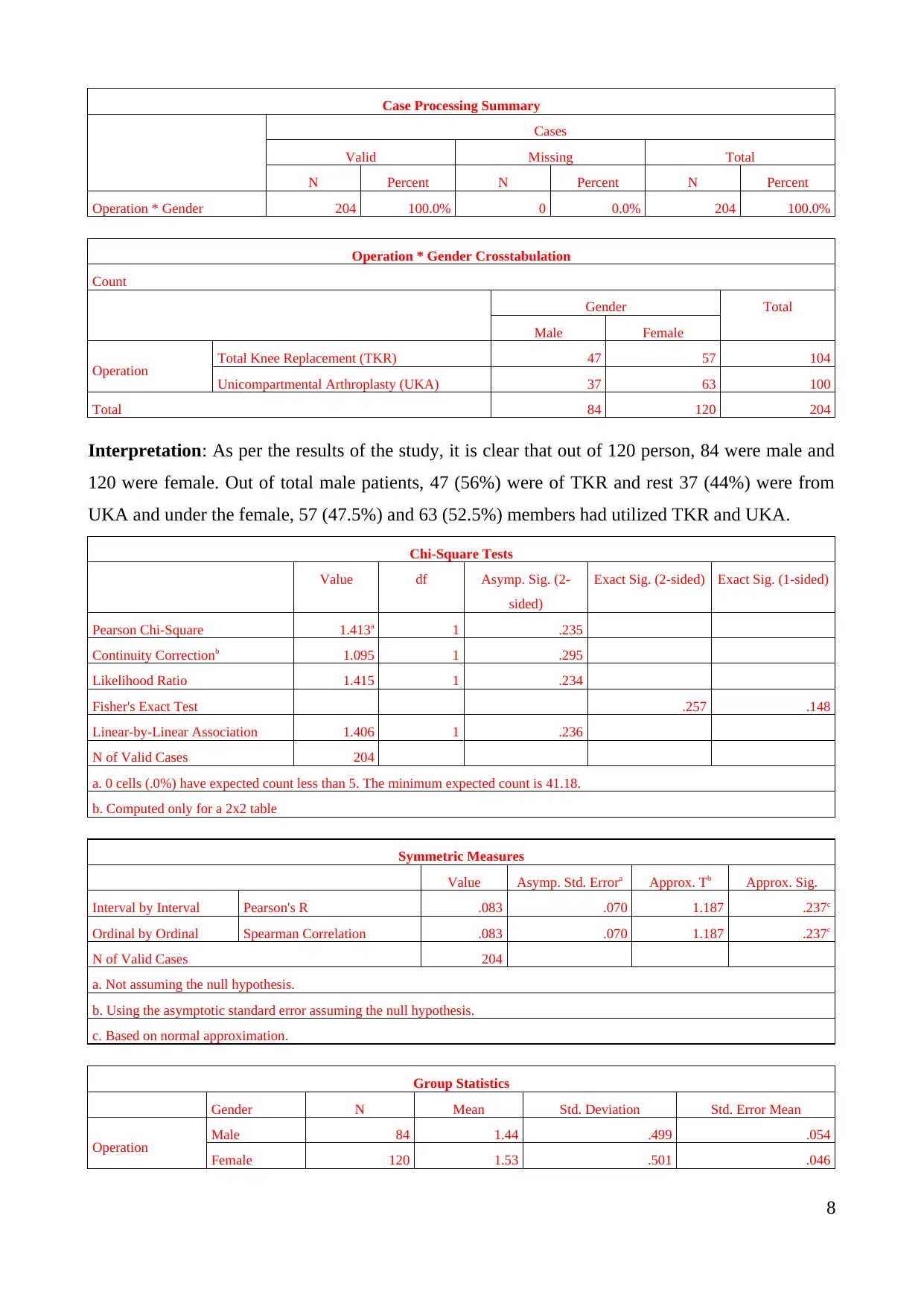
Case Processing Summary
Cases
Valid Missing Total
N Percent N Percent N Percent
Operation * Gender 204 100.0% 0 0.0% 204 100.0%
Operation * Gender Crosstabulation
Count
Gender Total
Male Female
Operation Total Knee Replacement (TKR) 47 57 104
Unicompartmental Arthroplasty (UKA) 37 63 100
Total 84 120 204
Interpretation: As per the results of the study, it is clear that out of 120 person, 84 were male and
120 were female. Out of total male patients, 47 (56%) were of TKR and rest 37 (44%) were from
UKA and under the female, 57 (47.5%) and 63 (52.5%) members had utilized TKR and UKA.
Chi-Square Tests
Value df Asymp. Sig. (2-
sided)
Exact Sig. (2-sided) Exact Sig. (1-sided)
Pearson Chi-Square 1.413a 1 .235
Continuity Correctionb 1.095 1 .295
Likelihood Ratio 1.415 1 .234
Fisher's Exact Test .257 .148
Linear-by-Linear Association 1.406 1 .236
N of Valid Cases 204
a. 0 cells (.0%) have expected count less than 5. The minimum expected count is 41.18.
b. Computed only for a 2x2 table
Symmetric Measures
Value Asymp. Std. Errora Approx. Tb Approx. Sig.
Interval by Interval Pearson's R .083 .070 1.187 .237c
Ordinal by Ordinal Spearman Correlation .083 .070 1.187 .237c
N of Valid Cases 204
a. Not assuming the null hypothesis.
b. Using the asymptotic standard error assuming the null hypothesis.
c. Based on normal approximation.
Group Statistics
Gender N Mean Std. Deviation Std. Error Mean
Operation Male 84 1.44 .499 .054
Female 120 1.53 .501 .046
8
Cases
Valid Missing Total
N Percent N Percent N Percent
Operation * Gender 204 100.0% 0 0.0% 204 100.0%
Operation * Gender Crosstabulation
Count
Gender Total
Male Female
Operation Total Knee Replacement (TKR) 47 57 104
Unicompartmental Arthroplasty (UKA) 37 63 100
Total 84 120 204
Interpretation: As per the results of the study, it is clear that out of 120 person, 84 were male and
120 were female. Out of total male patients, 47 (56%) were of TKR and rest 37 (44%) were from
UKA and under the female, 57 (47.5%) and 63 (52.5%) members had utilized TKR and UKA.
Chi-Square Tests
Value df Asymp. Sig. (2-
sided)
Exact Sig. (2-sided) Exact Sig. (1-sided)
Pearson Chi-Square 1.413a 1 .235
Continuity Correctionb 1.095 1 .295
Likelihood Ratio 1.415 1 .234
Fisher's Exact Test .257 .148
Linear-by-Linear Association 1.406 1 .236
N of Valid Cases 204
a. 0 cells (.0%) have expected count less than 5. The minimum expected count is 41.18.
b. Computed only for a 2x2 table
Symmetric Measures
Value Asymp. Std. Errora Approx. Tb Approx. Sig.
Interval by Interval Pearson's R .083 .070 1.187 .237c
Ordinal by Ordinal Spearman Correlation .083 .070 1.187 .237c
N of Valid Cases 204
a. Not assuming the null hypothesis.
b. Using the asymptotic standard error assuming the null hypothesis.
c. Based on normal approximation.
Group Statistics
Gender N Mean Std. Deviation Std. Error Mean
Operation Male 84 1.44 .499 .054
Female 120 1.53 .501 .046
8
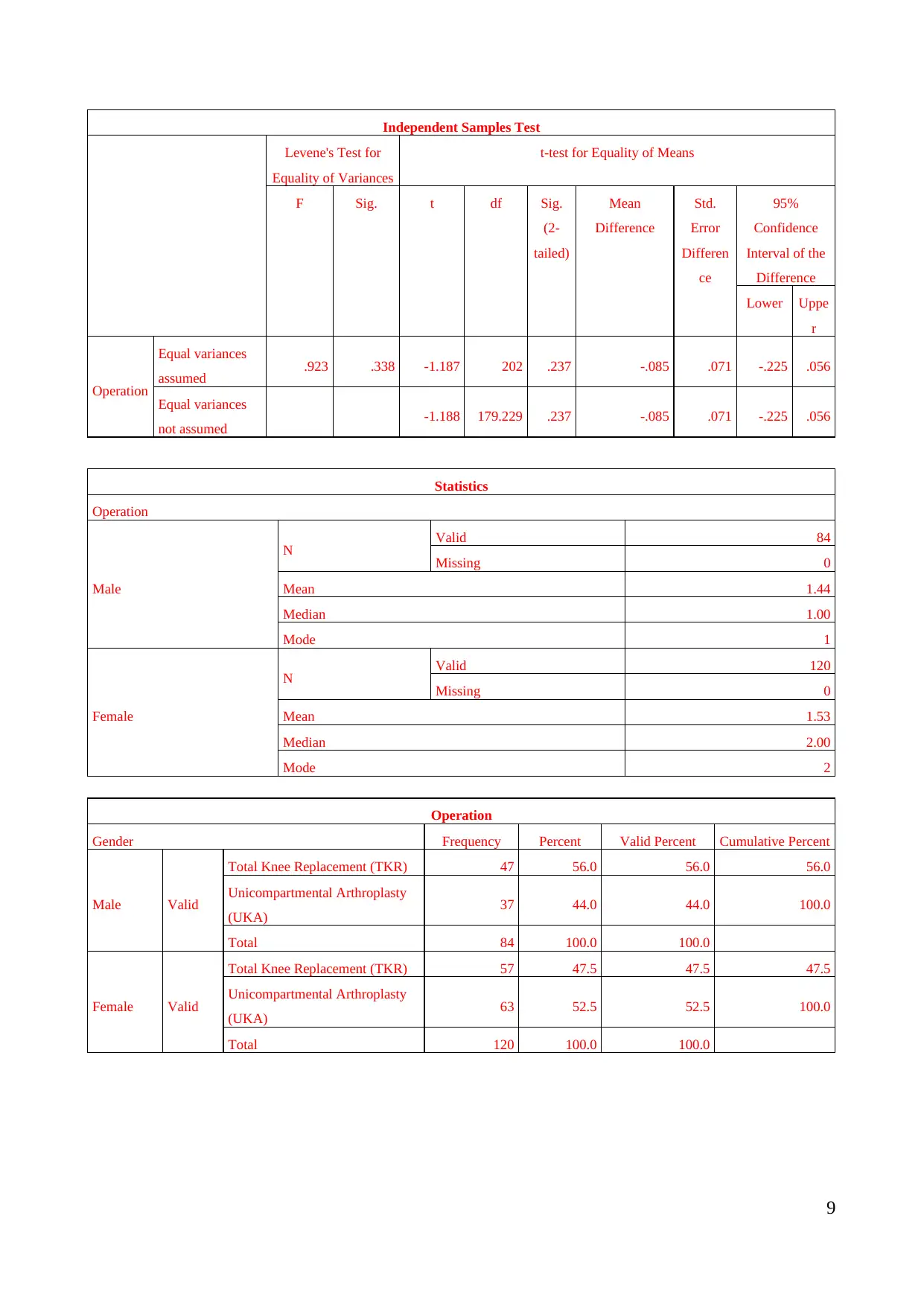
Independent Samples Test
Levene's Test for
Equality of Variances
t-test for Equality of Means
F Sig. t df Sig.
(2-
tailed)
Mean
Difference
Std.
Error
Differen
ce
95%
Confidence
Interval of the
Difference
Lower Uppe
r
Operation
Equal variances
assumed .923 .338 -1.187 202 .237 -.085 .071 -.225 .056
Equal variances
not assumed -1.188 179.229 .237 -.085 .071 -.225 .056
Statistics
Operation
Male
N Valid 84
Missing 0
Mean 1.44
Median 1.00
Mode 1
Female
N Valid 120
Missing 0
Mean 1.53
Median 2.00
Mode 2
Operation
Gender Frequency Percent Valid Percent Cumulative Percent
Male Valid
Total Knee Replacement (TKR) 47 56.0 56.0 56.0
Unicompartmental Arthroplasty
(UKA) 37 44.0 44.0 100.0
Total 84 100.0 100.0
Female Valid
Total Knee Replacement (TKR) 57 47.5 47.5 47.5
Unicompartmental Arthroplasty
(UKA) 63 52.5 52.5 100.0
Total 120 100.0 100.0
9
Levene's Test for
Equality of Variances
t-test for Equality of Means
F Sig. t df Sig.
(2-
tailed)
Mean
Difference
Std.
Error
Differen
ce
95%
Confidence
Interval of the
Difference
Lower Uppe
r
Operation
Equal variances
assumed .923 .338 -1.187 202 .237 -.085 .071 -.225 .056
Equal variances
not assumed -1.188 179.229 .237 -.085 .071 -.225 .056
Statistics
Operation
Male
N Valid 84
Missing 0
Mean 1.44
Median 1.00
Mode 1
Female
N Valid 120
Missing 0
Mean 1.53
Median 2.00
Mode 2
Operation
Gender Frequency Percent Valid Percent Cumulative Percent
Male Valid
Total Knee Replacement (TKR) 47 56.0 56.0 56.0
Unicompartmental Arthroplasty
(UKA) 37 44.0 44.0 100.0
Total 84 100.0 100.0
Female Valid
Total Knee Replacement (TKR) 57 47.5 47.5 47.5
Unicompartmental Arthroplasty
(UKA) 63 52.5 52.5 100.0
Total 120 100.0 100.0
9
⊘ This is a preview!⊘
Do you want full access?
Subscribe today to unlock all pages.

Trusted by 1+ million students worldwide
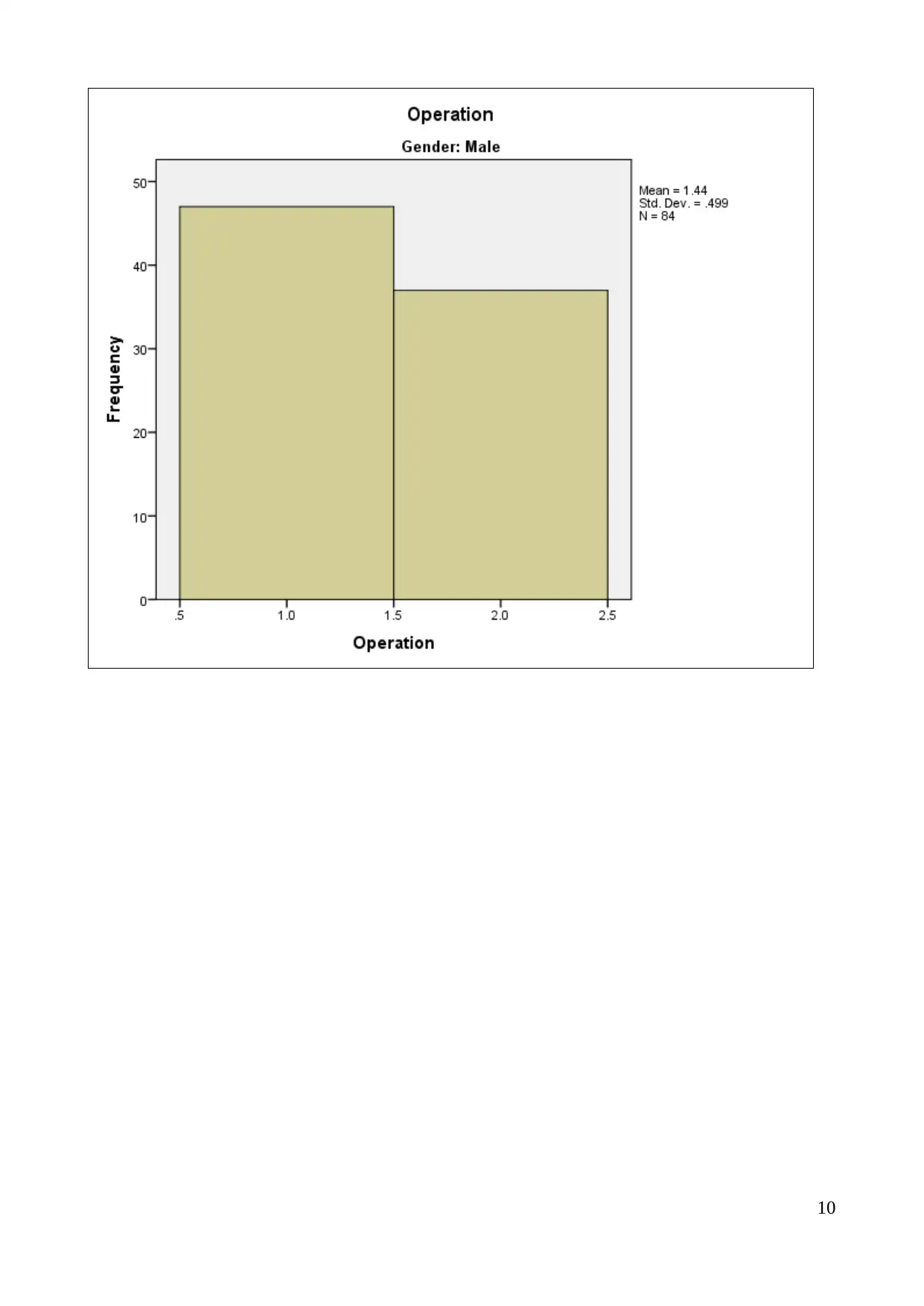
10
Paraphrase This Document
Need a fresh take? Get an instant paraphrase of this document with our AI Paraphraser
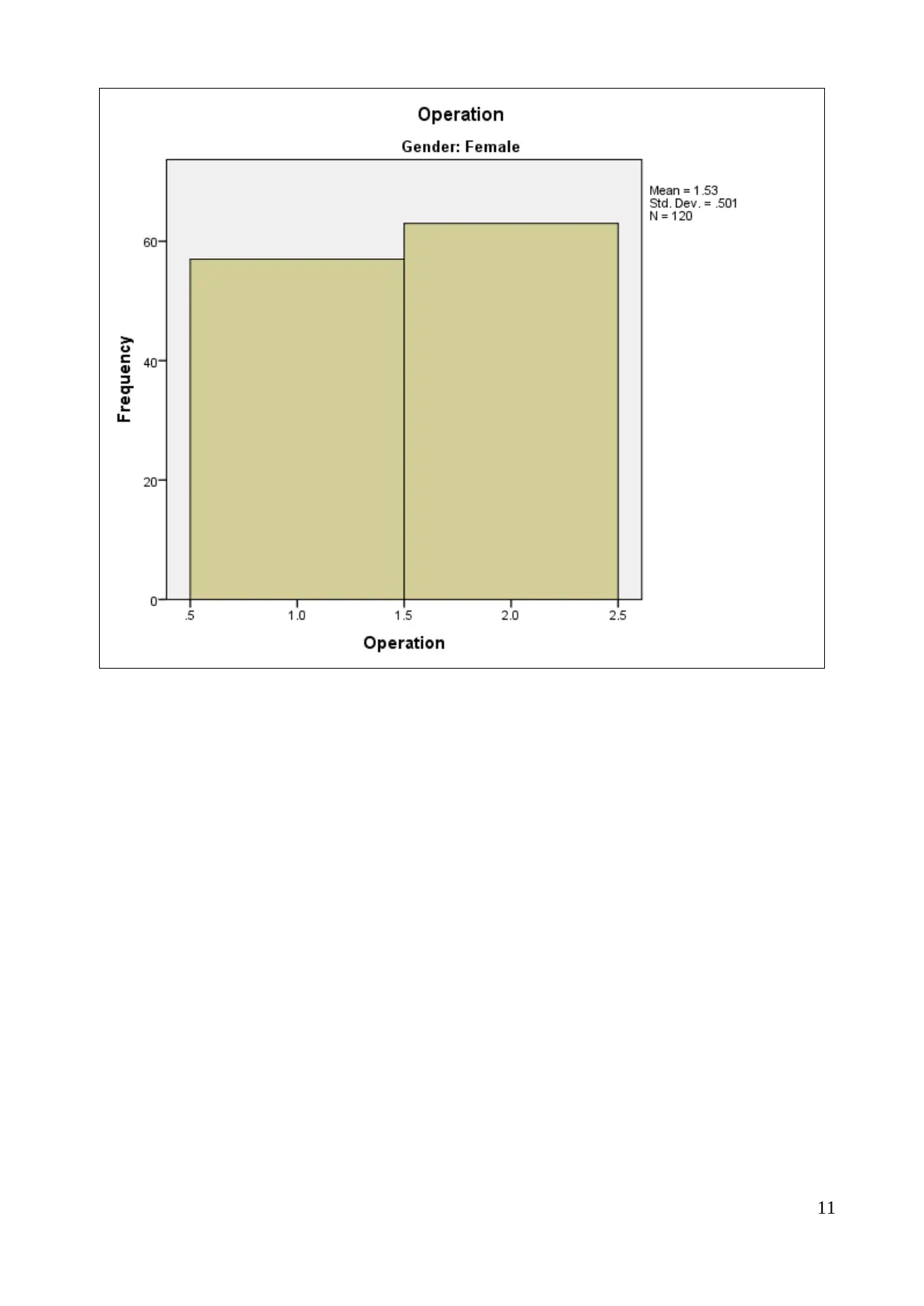
11
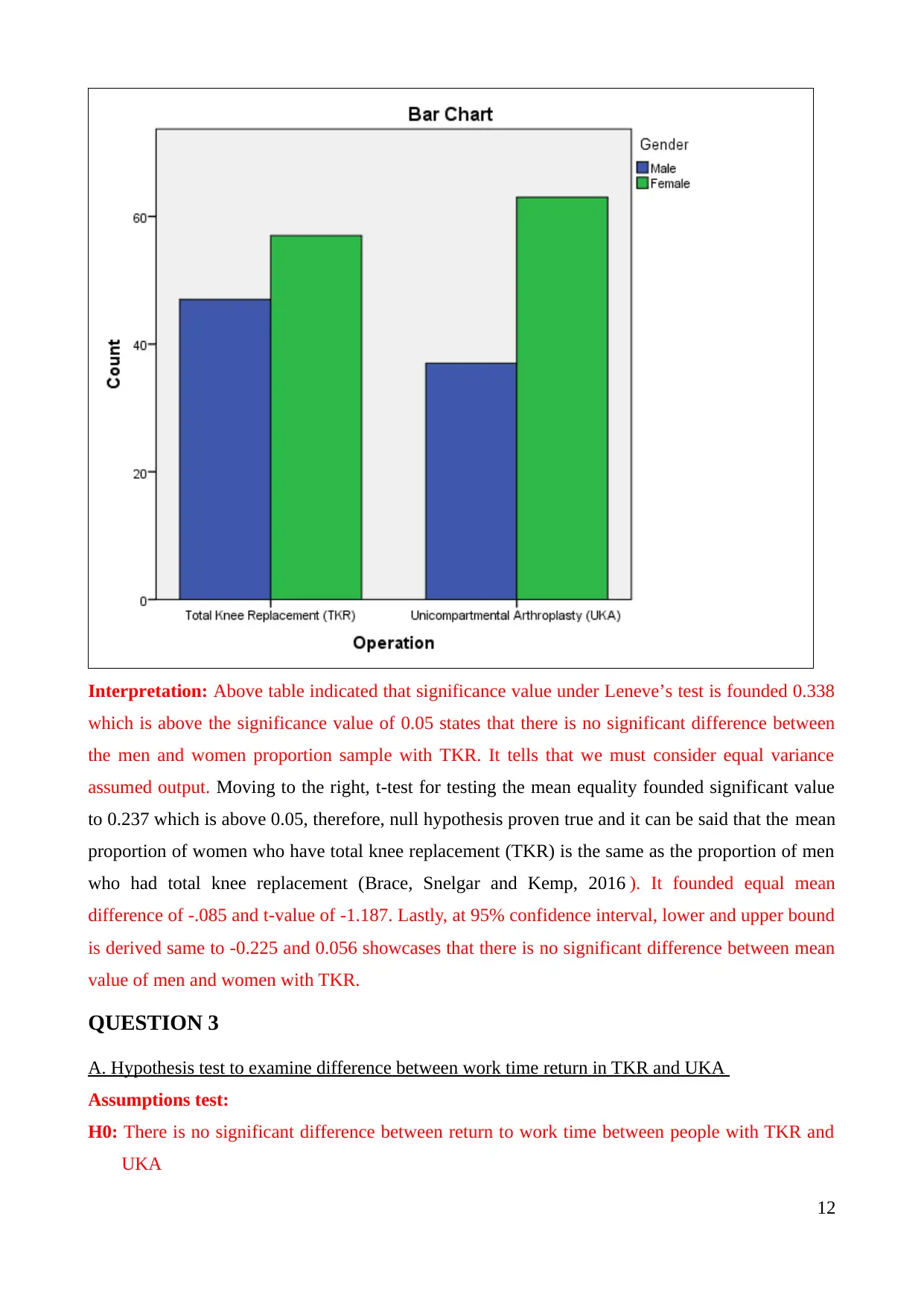
Interpretation: Above table indicated that significance value under Leneve’s test is founded 0.338
which is above the significance value of 0.05 states that there is no significant difference between
the men and women proportion sample with TKR. It tells that we must consider equal variance
assumed output. Moving to the right, t-test for testing the mean equality founded significant value
to 0.237 which is above 0.05, therefore, null hypothesis proven true and it can be said that the mean
proportion of women who have total knee replacement (TKR) is the same as the proportion of men
who had total knee replacement (Brace, Snelgar and Kemp, 2016 ). It founded equal mean
difference of -.085 and t-value of -1.187. Lastly, at 95% confidence interval, lower and upper bound
is derived same to -0.225 and 0.056 showcases that there is no significant difference between mean
value of men and women with TKR.
QUESTION 3
A. Hypothesis test to examine difference between work time return in TKR and UKA
Assumptions test:
H0: There is no significant difference between return to work time between people with TKR and
UKA
12
which is above the significance value of 0.05 states that there is no significant difference between
the men and women proportion sample with TKR. It tells that we must consider equal variance
assumed output. Moving to the right, t-test for testing the mean equality founded significant value
to 0.237 which is above 0.05, therefore, null hypothesis proven true and it can be said that the mean
proportion of women who have total knee replacement (TKR) is the same as the proportion of men
who had total knee replacement (Brace, Snelgar and Kemp, 2016 ). It founded equal mean
difference of -.085 and t-value of -1.187. Lastly, at 95% confidence interval, lower and upper bound
is derived same to -0.225 and 0.056 showcases that there is no significant difference between mean
value of men and women with TKR.
QUESTION 3
A. Hypothesis test to examine difference between work time return in TKR and UKA
Assumptions test:
H0: There is no significant difference between return to work time between people with TKR and
UKA
12
⊘ This is a preview!⊘
Do you want full access?
Subscribe today to unlock all pages.

Trusted by 1+ million students worldwide
1 out of 17
Related Documents
Your All-in-One AI-Powered Toolkit for Academic Success.
+13062052269
info@desklib.com
Available 24*7 on WhatsApp / Email
![[object Object]](/_next/static/media/star-bottom.7253800d.svg)
Unlock your academic potential
Copyright © 2020–2025 A2Z Services. All Rights Reserved. Developed and managed by ZUCOL.





